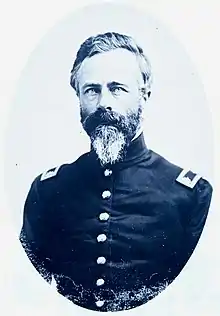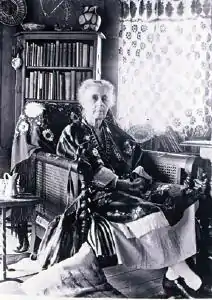Thomas Williams (Union general)
Thomas R. Williams (January 16, 1815 – August 5, 1862) was an antebellum United States Army officer and a brigadier general in the Union Army during the Civil War. He was killed as he commanded the Union troops at the Battle of Baton Rouge.[1]
Thomas R. Williams | |
|---|---|
 Civil War General Thomas Williams (1815–1862) who died in the Battle of Baton Rouge | |
| Born | January 16, 1815 Albany, New York |
| Died | August 5, 1862 (aged 47) Baton Rouge, Louisiana |
| Place of burial | |
| Allegiance | United States Union |
| Service/ | United States Army Union Army |
| Years of service | 1832, 1837–1862 |
| Rank | |
| Unit | Department of the Gulf |
| Commands held | Williams' Brigade |
| Battles/wars | Black Hawk War Second Seminole War Mexican War American Civil War |
| Other work | career soldier |
Birth and early years
Williams was born in 1815 in Albany, New York.[2][3] His father was General John R. Williams, the first Mayor of Detroit[4] and prominent military figure in Michigan. His father married his cousin, Mary Mott,[3] of one of Albany's leading families. Williams was the fifth of nine surviving children.[3]
Williams' grandfather, Thomas Williams, settled in Detroit in 1765 and the Williams family remained there from that time.[1] Prior to Detroit, the Williams family had settled in Albany, New York in 1690.[1]
Military career
He began his military service in 1832 as a private in an infantry company during the Black Hawk War, serving as a trumpeter under his father's command.[5]
The following year, Williams received an appointment to attend the United States Military Academy, then graduated in the Class of 1837 and he also taught mathematics at West Point in 1844.[6] He was breveted as a second lieutenant of the 4th U. S. Artillery. He later served in the Seminole Wars as a first Lieutenant and Assistant Commissary of Substance. Williams served in the Mexican War and was brevetted as a captain on August 20, 1847. He was brevetted as a major on September 13, 1847, for "meritorious service" in the war.[5]

Following the Mexican War, in 1852 Williams was promoted to full captain and posted to Fort Mackinac on Mackinac Island, Michigan, where he met and married Mary Neosho Bailey,[9] the daughter of Dr. Joseph Hayward Bailey, who served as a Surgeon in the U.S. Army. Her Dutch ancestors were from the Hudson River Valley area and New England.[1] Williams would serve as the commander of Fort Mackinac with the 4th Regiment of Artillery from 1852 to 1856.
Williams was later assigned to posts in Florida and the Utah Territory. By the late 1850s, he was serving as an instructor at the Artillery School at Fort Monroe in Virginia.[10]
Civil War and death
Shortly after the Civil War began, Williams was promoted to major in the 5th U. S. Artillery on May 14, 1861. On September 28, 1861, President Abraham Lincoln promoted Williams to Brigadier General of U. S. Volunteers, to rank from that date and on February 3, 1862, the U.S. Senate confirmed his nomination.[11] He was posted to the command of a brigade on the Potomac River, and was later posted to Fort Hatteras, North Carolina. He then was assigned to Maj. Gen. Benjamin Butler's command in the land operations against New Orleans, Louisiana. Williams and his brigade were assigned the task of occupying Baton Rouge. On May 29, General Williams arrived in the city with six regiments of infantry, two artillery batteries, and a troop of cavalry.
During the early summer, Williams' 3,000-man infantry brigade began work on what later became known as Grant's Canal, cutting a new channel across the base of De Soto Point on the west side of the Mississippi River across from Vicksburg, Mississippi. The purpose of the canal was to develop a channel for navigation that would enable gunboats and transports to bypass the Confederate batteries at Vicksburg.
In August 1862, Confederate forces under the command of General John C. Breckinridge attacked the Union defenses of Baton Rouge in an effort to retake the state's capital. In the resulting engagement, the Battle of Baton Rouge, Williams was killed by a gunshot wound to his chest on August 5, 1862, while leading what proved to be the successful defense of the city.[12] It was rumored that it was friendly fire.[13]
Williams's body was aboard the transport steamer Whiteman or Lewis Whitman (sources differ) along with other dead and wounded from the Battle of Baton Rouge when the steamer sank in the Mississippi River near Donaldsonville, Louisiana, with the loss of all hands after colliding with the United States Navy sloop-of-war USS Oneida on August 7, 1862.[14][15] Williams's body was recovered, and he was buried in the family plot in Elmwood Cemetery in Detroit, Michigan.[16]
A bronze memorial plaque was dedicated to Williams on 12 Aug 1907 at Fort Mackinac, with the dedication led by the Bishop of Michigan,[17] Charles David Williams. The plaque, located at the top of the ramp near the entrance by the South Sally Port,[18] reads: “In Memory of General Thomas Williams, Commandant of Fort Mackinac, 1852-1856, Killed in Battle, August 5, 1862.”[19]
Personal life
Williams had two sons, John R. Williams and Gershom Mott Williams, and a daughter named Mary Josepha Williams.[20] Gershom was the first bishop of the Episcopal Diocese of Marquette and he published General Williams' personal papers.[21] Josepha, was a physician and like her mother, Mary Neosho Williams, a significant landowner in Evergreen, Colorado.[22] She and Dr. Madeline Marquette founded the Marquette-Williams Sanitarium, a medical and surgical center, in Denver, Colorado in 1888. In 1892, they established a nursing school in conjunction with the sanitarium.[23] Josepha was married in 1896 to Canon Charles Winfred Douglas,[24] an Episcopalian priest and expert in plainsong music.[25]
Notes
- "The Rev. G. Mott Williams, M.A.". The Churchman. Churchman Company. 1895. p. 709.
- Thomas H. Richey (September 1, 2005). The Battle of Baton Rouge. Virtualbookworm Publishing. pp. 17–18. ISBN 978-1-58939-770-5.
- Clarence Monroe Burton; William Stocking; Gordon K. Miller (1922). The City of Detroit, Michigan, 1701-1922. S. J. Clarke publishing Company. p. 1402.
- Clarence Monroe Burton; William Stocking; Gordon K. Miller (1922). The City of Detroit, Michigan, 1701-1922. S. J. Clarke publishing Company. pp. 926, 1294–1295.
- Elmwood Cemetery webpage for General Williams
- Appletons' annual cyclopaedia and register of important events of the year: 1862. New York: D. Appleton & Company. 1863. p. 670.
- "Evergreen Conference District Nomination Form" (PDF). National Register of Historic Places. National Park Service. Retrieved October 6, 2016.
- "Jefferson County Neighborhoods: The Hiwans of Evergreen". City and Mountain Views. Retrieved October 6, 2016.
- Michigan government documents
- Trail-R-Us: John Hunt Morgan
- Eicher, John H., and David J. Eicher, Civil War High Commands. Stanford: Stanford University Press, 2001. ISBN 0-8047-3641-3. p. 731
- Trails-R-Us
- Garrison, Webb (1999). Friendly Fire in the Civil War: More Than 100 True Stories of Comrade Killing Comrade. Nashville, TN: Rutledge Hill Press, Inc. pp. Chapter 15. ISBN 978-1595552297.
- Gaines, W. Craig, Encyclopedia of Civil War Shipwrecks, Louisiana State University Press, 2008 Archived 2010-11-29 at the Wayback Machine, ISBN 978-0-8071-3274-6., p. 104.
- Naval History and Heritage Command Dictionary of American Naval Fighting Ships Oneida II (Screw Sloop of War)
- Find-a-Grave bio and photo
- The Churchman (Hartford, Conn.), Vol. 96, 24 Aug 1907, p. 275.
- Straus, Frank. A Look at History: Fort Mackinac’s South Sally Port Contains Reminder of Cost of Civil War. Mackinac Island Town Crier (Mackinac Island, Mich.), 24 May 2014.
- May, George F. Michigan Civil War Monuments: Part Three: Mackinaw - Wayne Counties. Michigan Civil War Centennial Observance Commission, 1965.
- Michigan Supreme Court; Harry Burns Hutchins; Randolph Manning (1879). Michigan Reports: Cases Decided in the Supreme Court of Michigan. Phelphs & Stevens, printers. p. 558.
- "Michigan's Tuition Charges Were Small in 1827". The Michigan Alumnus. UM Libraries. 1935. p. 521. UOM:39015006954393.
Biographical information about John R. Williams and other family members.
- Melanie Shellenbarger (November 1, 2012). High Country Summers: The Early Second Homes of Colorado, 1880Ð1940. University of Arizona Press. p. 238. ISBN 978-0-8165-2958-2.
- Tom Sherlock (April 15, 2013). Colorado's Healthcare Heritage: A Chronology of the Nineteenth and Twentieth Centuries Volume One — 1800-1899. iUniverse. p. 363. ISBN 978-1-4759-8026-4.
- Thomas J. Noel (February 28, 2007). Guide to Colorado Historic Places: Sites Supported by the Colorado Historical Society's State Historical Fund. Big Earth Publishing. p. 178. ISBN 978-1-56579-493-1.
- "Evergreen Conference District Nomination Form" (PDF). National Register of Historic Places. National Park Service. Retrieved October 6, 2016.
References
- Eicher, John H., and David J. Eicher, Civil War High Commands. Stanford: Stanford University Press, 2001. ISBN 0-8047-3641-3.
- "Letters of General Thomas Williams, 1862". The American Historical Review. The American Historical Review, Vol. 14, No. 2. 14 (2): 304–328. 1909. doi:10.2307/1832660. JSTOR 1832660.
- Elmwood Cemetery Biography